 |
BusTalk
A Community Discussing Buses and Bus Operations Worldwide!
|
| View previous topic :: View next topic |
| Author |
Message |
Gazpachot
Joined: 23 Nov 2009
Posts: 2
|
 Posted: Mon Nov 23, 2009 10:29 pm Post subject: Old bus stop signs and collection device... Posted: Mon Nov 23, 2009 10:29 pm Post subject: Old bus stop signs and collection device... |
 |
|
Hello,
Great resource this is...
My father, who grew up in New York City 1933-55, recently expressed great interest in two items: the old metal black and white bus stop signs with the arrow pointing upwards, and the unusual collection device that the fare collectors would use on certain double decker busses (5th Avenue line?). What was this item called I wonder?
I'd be very interested to know where I could get a hold of either/both of these as a Xmas present for him as I know he has very great memories of his days of bus travel in Manhattan and these two pieces seem to have special meaning. I've tried the usual suspects - ebay & craigslist - to no avail.
Any thoughts would be greatly appreciated!
My best,
Paul "Gazpachot" |
|
| Back to top |
|
 |
Mr. Linsky
BusTalk's Offical Welcoming Committee

Joined: 16 Apr 2007
Posts: 5071
Location: BRENTWOOD, CA. - WOODMERE, N.Y.
|
 Posted: Tue Nov 24, 2009 1:50 am Post subject: Posted: Tue Nov 24, 2009 1:50 am Post subject: |
 |
|
Gazpachot,
Welcome to BusTalk - glad to have you aboard - looking forward to your valued contributions.
By your description, I would assume that you talk of the Bus Stop sign specimen pictured below (lower frame).
This was a New York City staple for decades and is a rarity now. However you certainly can try eBay and perhaps you'll be lucky.
As far as Fare Boxes go, all New York City owned buses along with some private companies used the Johnson Model 'D' (my own is pictured) in either manual or electric option.
These boxes are comparatively easy to come by, again on eBay.
I have no idea as to what boxes Fifth Avenue used on their DD's before they retired in 1953 - you'd have to research that one a little further.
Hope I've helped.
Mr. Linsky - Green Bus Lines, Inc., Jamaica, NY
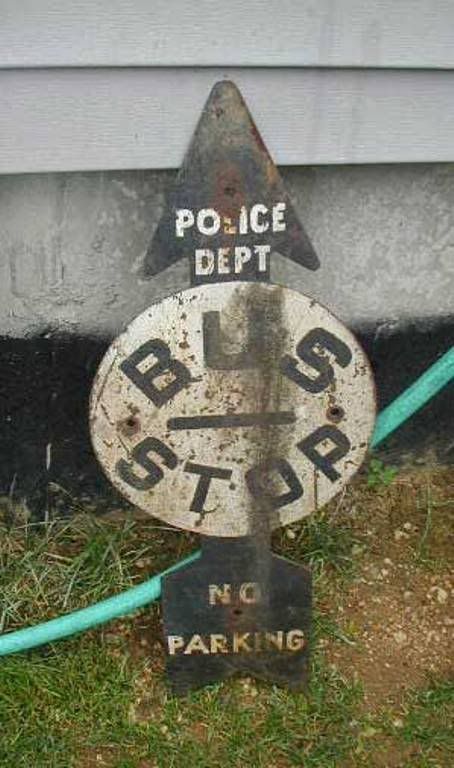
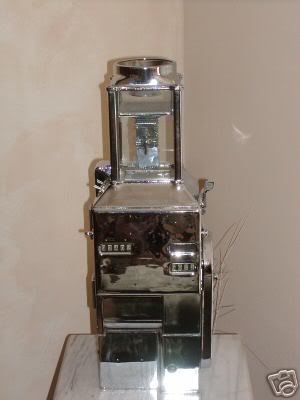 |
|
| Back to top |
|
 |
Hart Bus
Age: 74
Joined: 24 Apr 2007
Posts: 1150
|
 Posted: Tue Nov 24, 2009 11:37 am Post subject: Posted: Tue Nov 24, 2009 11:37 am Post subject: |
 |
|
To Gazpachot and everyone else......Let me echo my friend Mr. Linsky's warm greeting and hope that you become a contributor to this board. Everyone has some knowledge or memory that can be enhanced and built upon.
I remember the farebox pictured. In fact I was up at the Shoreline Trolley Museum Saturday for the annual meeting and we have a few of those boxes, now mounted on poles with signs for donations.
I also remember a large farebox, probably on the FACC route 15 that had a smooth retangular top with a slot for the coins. Then facing the driver was the chute in the form of a number six, where the coins would travel down one at a time to be counted and sorted into the different slots in the changemaker part of the machine.
For some of you younger members of Bus-Talk, YES, drivers did make change up until the 1960's. |
|
| Back to top |
|
 |
Mr. Linsky
BusTalk's Offical Welcoming Committee

Joined: 16 Apr 2007
Posts: 5071
Location: BRENTWOOD, CA. - WOODMERE, N.Y.
|
 Posted: Tue Nov 24, 2009 3:15 pm Post subject: Posted: Tue Nov 24, 2009 3:15 pm Post subject: |
 |
|
I thought this would be a good time to resurrect an essay I did way back when - it's apropos!
I call this ‘Ye Old Fare Boxes and Change Carriers’.
You youngsters may not remember but bus drivers in the days of yore actually made change and ‘hand cranked’ coins through their fare boxes along with coordinating transfers, shifting gears, opening and closing doors and, with all of this, managing to steer the bus in the right direction (usually!).
For decades Green Bus Lines of Jamaica, New York used a model ‘D’ ‘Johnson’ manual fare box (pictured below) which was affixed to a post at the dashboard in close proximity to the driver’s seat. These machines (which dated originally from 1909) were considered to be the ‘DC3’s’ of their ilk and were so rugged, well built and precise that they virtually never needed repair. Passengers would drop coins at the top of the box which the operator could see zigzagging down a shoot to a set of trap doors. Once enough coins accumulated at the doors the driver would then push a lever to send them to a counting mechanism. In the case of manual operation the driver would hand crank the coins through the counter and scoop them out from a hopper at the bottom of the box (NYCTS used the same machine but modified to crank electrically).
For more information on the model ‘D’ accompanied by some very interesting pictures go to www.johnsonfarebox.com and scroll to The Story of the Johnson Fare Box Company).
At sometime in the late fifties Green Line decided to go modern with the purchase of the all new ‘Grant Electro-farer’. The Electro-farer, which stood on its own special stanchion, resembled a pinball machine with a large viewing window and a maize that the coins had to travel down to be sorted into its ‘built in’ change carrier below (actually, it looked and sounded more like Robbie the Robot from the movie ‘Forbidden Planet’ – at least the writer thought so). Each denomination of coin would make a different tone of chime and the drivers became so accustomed to these sounds that they could focus more of their attention to driving as fares were being collected.
I mentioned the fact that the Electro-farer had its own ‘built in’ change carrier. This convenience signaled the end of the era in which drivers had to carry their own change makers.
The most common change carriers of the day were also manufactured by Johnson and usually had one tube each for quarters, nickels, dimes and pennies (they were considered to be a starter set and were just about the same as the Good Humor drivers used to carry).
But then there were the more sophisticated models manufactured by the McGill Company. The McGill machines (and that’s what they were) came in ‘modular’ form and could be custom constructed to meet any change vending need. You started with the two ends (each with a belt hook) and then added what tubes you required. There were drivers that had as many as eight sections.
The most unique feature of the McGill was the fact that you could adjust the delivery system up to five coins at a time (in other words, when the fare was thirteen cents and a passenger needed change for a nickel you could adjust the machine to flip out five pennies at once. These adjustable devices came in very handy as the fares began to increase from a nickel to seven cents, to a dime, to thirteen cents and so on.
Now I think you can see that years ago driving a bus wasn’t quite as easy as it looked!
Note; the Grant Box below shows the hopper option without the built-in change carrier.
Mr. Linsky – Green Bus Lines, Inc., Jamaica, NY
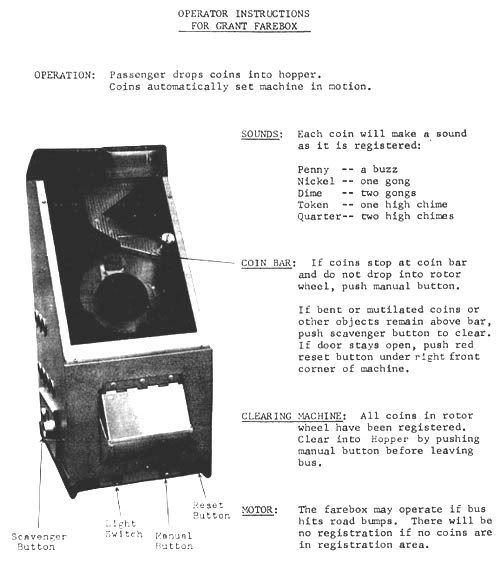
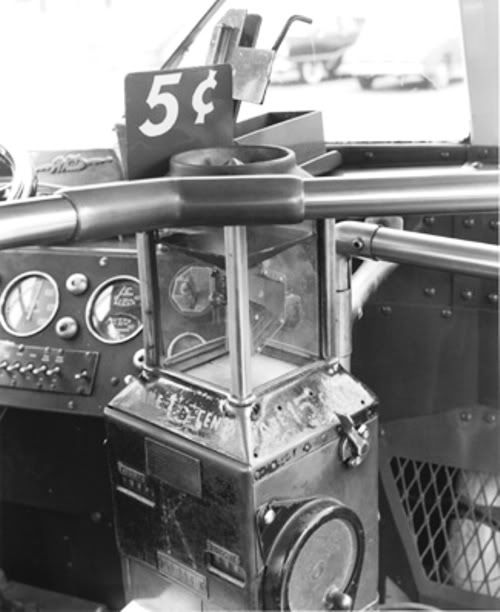 |
|
| Back to top |
|
 |
Gazpachot
Joined: 23 Nov 2009
Posts: 2
|
 Posted: Tue Nov 24, 2009 3:48 pm Post subject: Posted: Tue Nov 24, 2009 3:48 pm Post subject: |
 |
|
Wow! I am amazed by the outpouring of information and enthusiasm for these relics! Thank you all. Very welcoming and educational.
I wanted to add a detail. The fare collecting device my father was referring to was something specifically designed for fare collectors on double-decker busses. It had a grip not unlike a pistol or hand gun that attached to what I can only assume was a smaller version of the Johnson fare box. As my father tells it, they walked around the upper deck collecting fares. It was well known among kids that you could beat these fares easily by jumping off before he got to you (not that my dad ever did that!).
Thanks again, I look forward to reading more of the site and am especially open to any tips on finding these amazing artifacts...
Best,
Gazpachot |
|
| Back to top |
|
 |
Mr. Linsky
BusTalk's Offical Welcoming Committee

Joined: 16 Apr 2007
Posts: 5071
Location: BRENTWOOD, CA. - WOODMERE, N.Y.
|
 Posted: Tue Nov 24, 2009 7:03 pm Post subject: Posted: Tue Nov 24, 2009 7:03 pm Post subject: |
 |
|
Gazpachot,
I think I now get your drift!
Your father must have been speaking of the open deck Fifth Avenue Coaches (pictured below - top) that required both a driver and conductor (the conductor being more a fare collector at the outer rear stairway).
These buses, which dated from the early thirties, were retired in 1946 while later model fully enclosed double deckers continued until 1953 (also pictured below)
At Green Line, our starters used a chromium plated hand held device with something like a trigger to collect fares during the rush hour at rear doors - this might be the same instrument you refer to.
That's one item that I have never seen offered on the internet and, if any still existed, would certainly be rarities.
Top photo of FACCO # 1220 seen at the Southampton Automotive Museum circa 1950.
Bottom photo of FACCO Yellow Model 735 (Queen Mary) seen at Broadway and 26th. Street in Manhattan in 1939 courtesy of the New York City Archives.
Regards.
Mr. 'L'
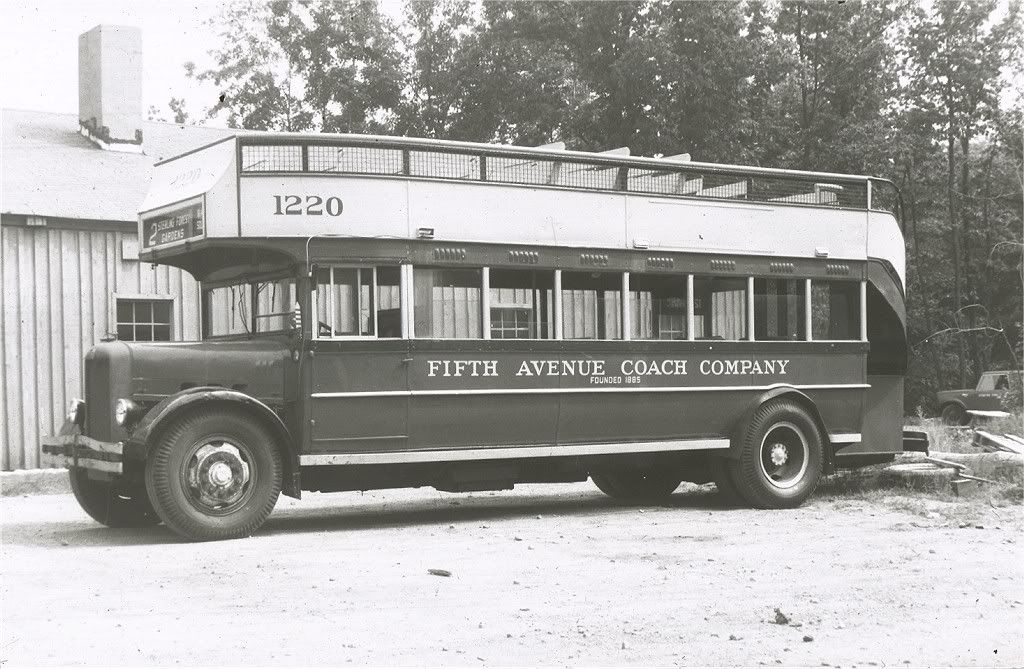
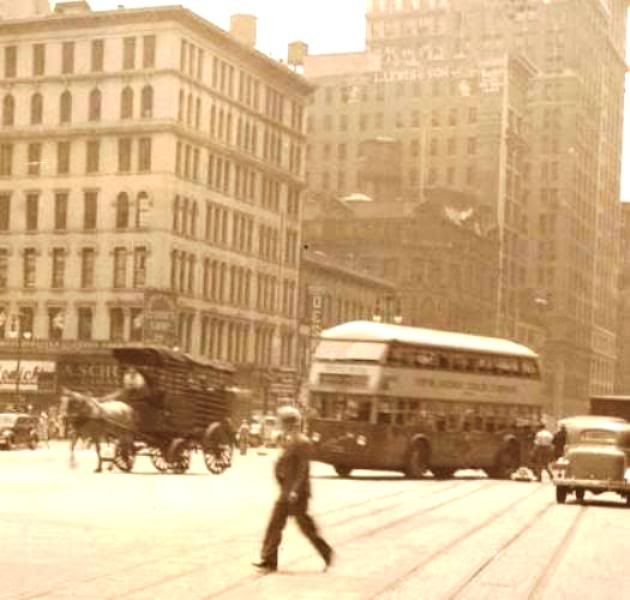 |
|
| Back to top |
|
 |
Hart Bus
Age: 74
Joined: 24 Apr 2007
Posts: 1150
|
 Posted: Wed Nov 25, 2009 11:41 am Post subject: Posted: Wed Nov 25, 2009 11:41 am Post subject: |
 |
|
| Mr. Linsky wrote: | I thought this would be a good time to resurrect an essay I did way back when - it's apropos!
I call this ‘Ye Old Fare Boxes and Change Carriers’.
You youngsters may not remember but bus drivers in the days of yore actually made change and ‘hand cranked’ coins through their fare boxes along with coordinating transfers, shifting gears, opening and closing doors and, with all of this, managing to steer the bus in the right direction (usually!).
For decades Green Bus Lines of Jamaica, New York used a model ‘D’ ‘Johnson’ manual fare box (pictured below) which was affixed to a post at the dashboard in close proximity to the driver’s seat. These machines (which dated originally from 1909) were considered to be the ‘DC3’s’ of their ilk and were so rugged, well built and precise that they virtually never needed repair. Passengers would drop coins at the top of the box which the operator could see zigzagging down a shoot to a set of trap doors. Once enough coins accumulated at the doors the driver would then push a lever to send them to a counting mechanism. In the case of manual operation the driver would hand crank the coins through the counter and scoop them out from a hopper at the bottom of the box (NYCTS used the same machine but modified to crank electrically).
For more information on the model ‘D’ accompanied by some very interesting pictures go to www.johnsonfarebox.com and scroll to The Story of the Johnson Fare Box Company).
At sometime in the late fifties Green Line decided to go modern with the purchase of the all new ‘Grant Electro-farer’. The Electro-farer, which stood on its own special stanchion, resembled a pinball machine with a large viewing window and a maize that the coins had to travel down to be sorted into its ‘built in’ change carrier below (actually, it looked and sounded more like Robbie the Robot from the movie ‘Forbidden Planet’ – at least the writer thought so). Each denomination of coin would make a different tone of chime and the drivers became so accustomed to these sounds that they could focus more of their attention to driving as fares were being collected.
I mentioned the fact that the Electro-farer had its own ‘built in’ change carrier. This convenience signaled the end of the era in which drivers had to carry their own change makers.
The most common change carriers of the day were also manufactured by Johnson and usually had one tube each for quarters, nickels, dimes and pennies (they were considered to be a starter set and were just about the same as the Good Humor drivers used to carry).
But then there were the more sophisticated models manufactured by the McGill Company. The McGill machines (and that’s what they were) came in ‘modular’ form and could be custom constructed to meet any change vending need. You started with the two ends (each with a belt hook) and then added what tubes you required. There were drivers that had as many as eight sections.
The most unique feature of the McGill was the fact that you could adjust the delivery system up to five coins at a time (in other words, when the fare was thirteen cents and a passenger needed change for a nickel you could adjust the machine to flip out five pennies at once. These adjustable devices came in very handy as the fares began to increase from a nickel to seven cents, to a dime, to thirteen cents and so on.
Now I think you can see that years ago driving a bus wasn’t quite as easy as it looked!
Note; the Grant Box below shows the hopper option without the built-in change carrier.
Mr. Linsky – Green Bus Lines, Inc., Jamaica, NY

 |
To my dear friend WCA a/k/a Mr. Linsky.
You are truly amazing with your knowledge, willingness to share it, and to find pictures of the item. I''m beginning to think that if Mr. Linsky doesn't know about it, it never existed.
Happy Thanksgiving to everyone including Mr Linsky. I hope your wife is keeping on the road to good health. I just hope it isn't as long as a round trip on the Q-60
 |
|
| Back to top |
|
 |
N4 Jamaica

Joined: 16 Apr 2007
Posts: 858
Location: Long Island
|
 Posted: Wed Nov 25, 2009 7:02 pm Post subject: Posted: Wed Nov 25, 2009 7:02 pm Post subject: |
 |
|
I remember the Fifth Avenue coach fare collection method, but my memory may play tricks on me. The device was not much larger than a hand and wrist. The conductor roamed both levels of the bus collecting fares, and fares were collected after passengers were seated. The conductor held the device so the passenger would insert the dime. I think the conductor squeezed a lever, which counted the coin and rang a small bell. The dime passed into the conductor's hand and then into his changer.
----
Dad was thrifty, so he did not ride a double-fare bus. Mom and her mother liked to ride Fifth Avenue with us kids, maybe because there was an air of elegance, but also because routes 4 or 5 would include views and a breeze along Riverside Drive. Having reached Washington Heights, they would then have to pay another fare on the K car to reach home on Marble Hill. Otherwise, we rode the Interborough, five cents anywhere on that system.
----
I never rode the open tops. Mom said that in her high school days the conductor would warn about standing on the upper deck while under the Ninth Avenue el at 110th Street.
----
I presume the use of these hand coin counters passed away with the elimination of bus and streetcar conductors. However, as Mr. Linsky points out, it could be a tool for curbside fare-collection.
Joe |
|
| Back to top |
|
 |
|
|
You cannot post new topics in this forum
You cannot reply to topics in this forum
You cannot edit your posts in this forum
You cannot delete your posts in this forum
You cannot vote in polls in this forum
You can attach files in this forum
You can download files in this forum
|
Powered by phpBB © 2001, 2005 phpBB Group
|








